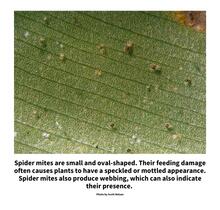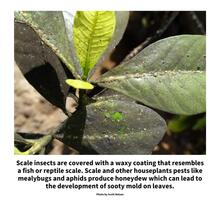
We often don’t think much about insect pests outside of the occasional pantry pest or accidental invader during the winter months. Despite it being the middle of winter, that doesn’t mean our plants won’t have insect problems. This is particularly true for houseplants, where insect pests often seem to arrive out of nowhere.
Why do pest populations on houseplants often increase during the winter?
Natural enemies will often keep pest populations in check when houseplants are outdoors. However, once we bring our plants indoors for winter, these natural enemies usually don’t come with or don’t survive. With no predators, parasites, or pathogens to keep them under control, pest populations can grow quickly and begin to cause noticeable damage to our plants.
Common houseplant pests
Spider mites are small (1/50 inch) and oval-shaped. They have sucking mouthparts and will feed on sap from plants. Their feeding damage often causes plants to have a speckled or mottled appearance. Spider mites also produce webbing, thus their name, which can also indicate their presence.
Scale insects are unique, and at first, appearance, don’t really resemble insects. Adult females are immobile (legless) and are covered with a waxy coating that resembles a fish or reptile scale, thus the name. These waxy coatings help protect the insects. Females lay eggs under their bodies. Once they hatch, the offspring are called crawlers because they have legs and will move around. They will wander around and find a spot to feed and start to produce their waxy covering. Once they molt, they will lose their legs and be in the same spot for the rest of their life.
Mealybugs are small, soft-bodied insects. They are covered in white, powdery, waxy secretions. They will often have small projections coming out from their sides as well as “tails.”
Scale and mealybugs have piercing-sucking mouthparts that they will use like straws to suck up plant sap. Their feeding can cause yellowing leaves, as reduced growth and stunted plants. Many will also produce honeydew, which can lead to the development of sooty mold on plants. They are most commonly found on the undersides of leaves, especially along the mid-veins.
Aphids are also small, soft-bodied insects. They are pear-shaped and have relatively long legs and antennae. Like scale and mealybugs, they have piercing-sucking mouthparts that they use to feed on plant sap and will also produce honeydew. Aphid feeding can cause leaves to turn yellow, and plants can become distorted and stunted. Aphids are commonly found on new growth and the undersides of leaves.
If you have small, black flying around your plants, there’s a good chance you have fungus gnats. The larvae of these insects feed on decaying organic matter and fungi in the growing media. Fortunately, they don’t usually damage plants. The presence of fungus gnats is usually a good indicator that your houseplants’ growing media is too moist.
How do I get rid of pests on my houseplants?
Like with managing pests on outdoor plants, we should also try practicing integrated pest management (IPM) with our houseplants.
- Take some time to observe/scout your plants occasionally for any pests. Remember that many houseplant pests like to hide, so the undersides of leaves are a good place to start. The sooner you find pests, the easier it will be to manage them.
- Washing plants with water is a good first step to managing houseplant pests. Leaves of plants can be wiped with a moist sponge or paper towel to remove insects and mites. This is also a good way to remove sooty mold from plants.
- Plants can also be sprayed with water to knock pests off. Doing this several times can help manage pests like aphids, spider mites, and other pests that aren’t firmly attached to plants (such as scale). Small plants can be sprayed off in a sink, while you may need to use the shower for larger plants.
- If you have a few scale insects on a plant, scrape them off with your fingernail or a piece of plastic like a credit card. Mealybugs can be removed by using tweezers or a cotton swab that has been dipped in alcohol.
- If fungus gnats are an issue, allow potting media to dry out between waterings. You can use yellow sticky traps to monitor for adults, but they probably won’t be enough to eliminate fungus gnats by themselves.
- If plants are severely infested with pests, it may be best to get rid of the plant and replace it. This will help prevent the pests from spreading to other plants you may have.
Pesticides are also an option when managing pests on houseplants. When selecting pesticides, they need to be labeled for use on indoor plants. Make sure to read and follow all label directions. If applying indoors, make sure to do it in a well-ventilated area and avoid getting the pesticides on things other than the plant(s) you are spraying.
If you use contact pesticides like pyrethrins, insecticidal soaps, neem, or plant extracts, make sure you get good coverage. Systemic pesticides, like imidacloprid, are taken up and moved throughout the plant. Because of this, they often remain effective for longer periods than contact pesticides (often for months).
Good Growing Tip of the Week: Many systemic pesticides are toxic to bees, so use caution when using on plants that flower and will eventually be moved outdoors. If you are overwintering tropical food plants like citrus indoors, and want to use a systemic pesticide, make sure you read the label. Systemic pesticides are not typically labeled for use on food crops.
Photographs: “Canna lily (Canna indica L., Indian shot” (Public Domain) by Plant pests and diseases; “Scale insects and sooty mold” (Public Domain) by Plant pests and diseases; “Hibiscus: Mealybugs on flower” (Public Domain) by Plant pests and diseases; “Plumeria: Mealybugs” (Public Domain) by Plant pests and diseases
Signup for our emails! Want to get notified when new Good Growing posts are available? SIGN ME UP
MEET THE AUTHOR
Ken Johnson is a Horticulture Educator with University of Illinois Extension, serving Calhoun, Cass, Greene, Morgan, and Scott counties since 2013. Ken provides horticulture programming with an emphasis on fruit and vegetable production, pest management, and beneficial insects. Through his programming, he aims to increase backyard food production and foster a greater appreciation of insects.


